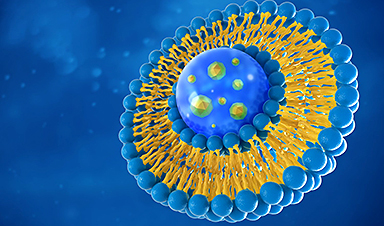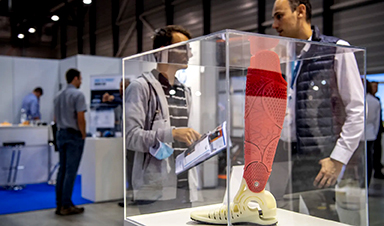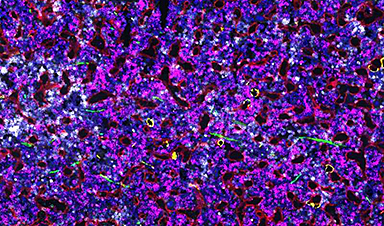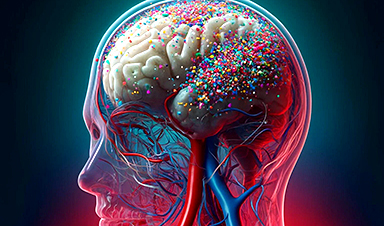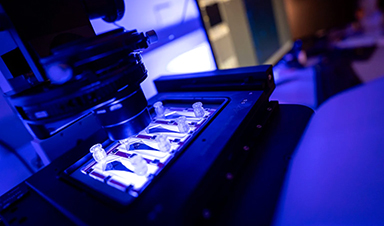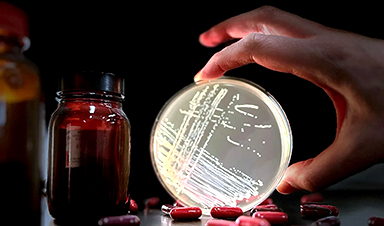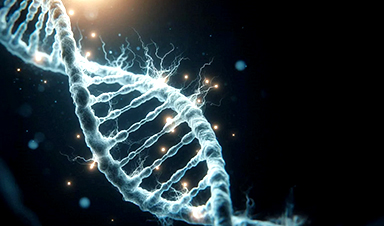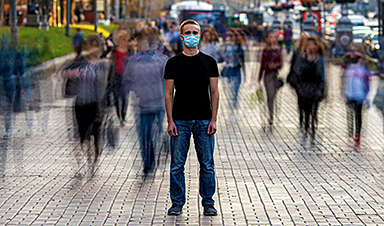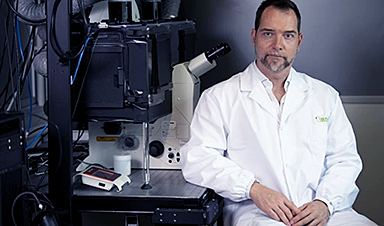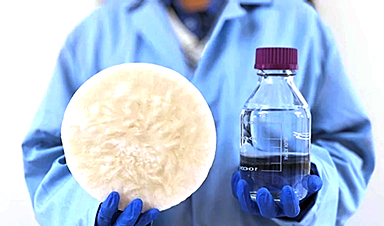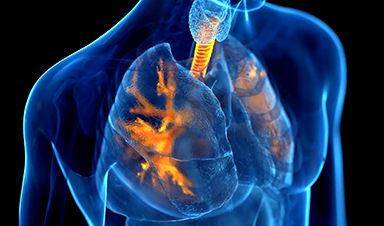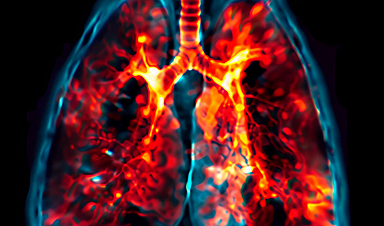Breakthrough medical technology like mRNA vaccines rely on tiny nanoparticles to deliver medicine to cells. A new device will help drug manufacturers and evaluators like the FDA more precisely measure genetic payloads to evaluate drug effectiveness.
An important component of the vaccines protecting people against SARS-CoV-2 virus and its variants are lipid nanoparticles, or LNPs. These circular particles carry therapeutic mRNA payloads, the snippets of genetic material that trigger our immune systems to defend against COVID-19. Even with their success, certain characteristics about the particles, such as payload distribution, are unknown. Researchers and the Food and Drug Administration want more insights about these characteristics to improve metrics reporting in pharmaceutical manufacturing.
A new molecular detection platform developed by two Whiting School of Engineering professors is answering the FDA’s call. Hai-Quan Mao and Tza-Huei (Jeff) Wang want to address how many mRNA molecules an LNP can carry and whether the mRNA is uniformly packed inside the particle to help researchers design more efficient and effective treatments and vaccines.
“Our platform processes molecules at the single nanoparticle level, but unlike the current imaging methods for mRNA LNPs, our approach is based on fluorescent spectroscopy and gives us the ability to see through the particles,” said Wang, a professor in the departments of Mechanical Engineering and Biomedical Engineering at the Whiting School, and a core researcher at the Institute for NanoBioTechnology.
The ability to peer inside the nanoparticles allows the researchers to differentiate between and measure empty LNPs that do not contain mRNA, LNPs with mRNA, and free-floating mRNA in a sample.
Their platform, called cylindrical illumination confocal spectroscopy, or CICS, works by tagging mRNA and LNP components with fluorescent signals of up to three colors and passing the sample through a detection plane. The detection plane reads the fluorescent signals and measures their intensity before comparing the strength of the intensities with that of a single mRNA molecule. The data analysis with an algorithm called deconvolution tells the team both how many mRNA copies are inside the LNP—if any—and their distribution in the sample. The team’s platform overcomes contrast limitations and increases the sample analysis throughput, that are seen in cryo-transmission electron microscopy, the current gold standard for imaging mRNA LNPs.
Tests conducted using this sensing platform revealed that from a benchmark solution of mRNA LNP used in academic research studies, over 50% of the LNPs are not loaded with mRNA molecules, and of the mRNA-filled LNPs, most of them contained two to three mRNA molecules per particle.
“Being able to quantitatively resolve payload characteristics of mRNA LNPs at the single particle level has never been done before. We are intrigued by the substantial presence of empty LNPs, and by altering formulation conditions, a single nanoparticle can load as few as one to as many as ten mRNA molecules.” said Mao, professor in the departments of Materials Science and Engineering and Biomedical Engineering at the Whiting School and director of the Institute for NanoBioTechnology.
The team’s results are published in Nature Communications.
“There are a lot of groups doing LNP research,” Wang said. “However, when they discover a formula that might work well, it has been hard to associate those discoveries back to the composition and payload distribution of the nanoparticles. With this platform we can provide a more comprehensive understanding on what is happening at the single particle level.”
More research is needed to learn how many mRNA molecules per LNP capsule is optimal for the most effective treatment. However, the empty LNPs revealed by the new platform show there is a need to improve methods for packaging the mRNA inside the LNPs.
Mao and Wang say that their platform shows that it has the potential to not only be used at all stages of LNP-related research and development, but also in the development of other drug delivery systems and quality control measures at the manufacturing stage. The team has filed a patent application covering the technique and is working with collaborators to use the platform to analyze other types of therapeutic cargos in diverse nanoparticle systems for treating different diseases.
“The FDA has recently addressed the need for better quality metrics in nanoparticle design in the pharmaceutical industry,” said Michael J. Mitchell, a leading scientist in the field of LNP research and Skirkanich Assistant Professor of Innovation in the Department of Bioengineering at the University of Pennsylvania. “This will become increasingly more important as mRNA LNP technology expands beyond vaccines into new therapeutics that are administered into the bloodstream, which have very stringent requirements. The new detection platform developed by Drs. Mao and Wang’s team is a potentially important step forward in addressing needs at the research and regulatory phase, and can potentially aid in the development of mRNA LNP technology beyond vaccines.”
News
Scientists Invent Plastic That Can Dissolve In Seawater In Just A Few Hours
Plastic waste and pollution in the sea have been among the most serious environmental problems for decades, causing immense damage to marine life and ecosystems. However, a breakthrough discovery may offer a game-changing solution. [...]
Muscles from the 3D printer
Swiss researchers have developed a method for printing artificial muscles out of silicone. In the future, these could be used on both humans and robots. Swiss researchers have succeeded in printing artificial muscles out [...]
Beneficial genetic changes observed in regular blood donors
Researchers at the Francis Crick Institute have identified genetic changes in blood stem cells from frequent blood donors that support the production of new, non-cancerous cells. Understanding the differences in the mutations that accumulate [...]
Shocking Amounts of Microplastics in the Brain – It Could Be Increasing Our Risk of Dementia
The brain has higher concentrations of plastic particles compared to other organs, with increased levels found in dementia patients. In a comprehensive commentary published in Brain Medicine, researchers highlight alarming new evidence of microplastic accumulation [...]
Baffling Scientists for Centuries: New Study Unravels Mystery of Static Electricity
ISTA physicists demonstrate that contact electrification depends on the contact history of materials. For centuries, static electricity has intrigued and perplexed scientists. Now, researchers from the Waitukaitis group at the Institute of Science and [...]
Tumor “Stickiness” – Scientists Develop Potential New Way To Predict Cancer’s Spread
UC San Diego researchers have developed a device that predicts breast cancer aggressiveness by measuring tumor cell adhesion. Weakly adherent cells indicate a higher risk of metastasis, especially in early-stage DCIS. This innovation could [...]
Scientists Just Watched Atoms Move for the First Time Using AI
Scientists have developed a groundbreaking AI-driven technique that reveals the hidden movements of nanoparticles, essential in materials science, pharmaceuticals, and electronics. By integrating artificial intelligence with electron microscopy, researchers can now visualize atomic-level changes that were [...]
Scientists Sound Alarm: “Safe” Antibiotic Has Led to an Almost Untreatable Superbug
A recent study reveals that an antibiotic used for liver disease patients may increase their risk of contracting a dangerous superbug. An international team of researchers has discovered that rifaximin, a commonly prescribed antibiotic [...]
Scientists Discover Natural Compound That Stops Cancer Progression
A discovery led by OHSU was made possible by years of study conducted by University of Portland undergraduates. Scientists have discovered a natural compound that can halt a key process involved in the progression [...]
Scientists Just Discovered an RNA That Repairs DNA Damage – And It’s a Game-Changer
Our DNA is constantly under threat — from cell division errors to external factors like sunlight and smoking. Fortunately, cells have intricate repair mechanisms to counteract this damage. Scientists have uncovered a surprising role played by [...]
What Scientists Just Discovered About COVID-19’s Hidden Death Toll
COVID-19 didn’t just claim lives directly—it reshaped mortality patterns worldwide. A major international study found that life expectancy plummeted across most of the 24 analyzed countries, with additional deaths from cardiovascular disease, substance abuse, and mental [...]
Self-Propelled Nanoparticles Improve Immunotherapy for Non-Invasive Bladder Cancer
A study led by Pohang University of Science and Technology (POSTECH) and the Institute for Bioengineering of Catalonia (IBEC) in South Korea details the creation of urea-powered nanomotors that enhance immunotherapy for bladder cancer. The nanomotors [...]
Scientists Develop New System That Produces Drinking Water From Thin Air
UT Austin researchers have developed a biodegradable, biomass-based hydrogel that efficiently extracts drinkable water from the air, offering a scalable, sustainable solution for water access in off-grid communities, emergency relief, and agriculture. Discarded food [...]
AI Unveils Hidden Nanoparticles – A Breakthrough in Early Disease Detection
Deep Nanometry (DNM) is an innovative technique combining high-speed optical detection with AI-driven noise reduction, allowing researchers to find rare nanoparticles like extracellular vesicles (EVs). Since EVs play a role in disease detection, DNM [...]
Inhalable nanoparticles could help treat chronic lung disease
Nanoparticles designed to release antibiotics deep inside the lungs reduced inflammation and improved lung function in mice with symptoms of chronic obstructive pulmonary disease By Grace Wade Delivering medication to the lungs with inhalable nanoparticles [...]
New MRI Study Uncovers Hidden Lung Abnormalities in Children With Long COVID
Long COVID is more than just lingering symptoms—it may have a hidden biological basis that standard medical tests fail to detect. A groundbreaking study using advanced MRI technology has uncovered significant lung abnormalities in [...]
